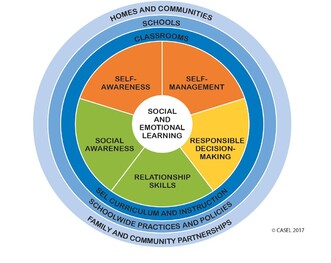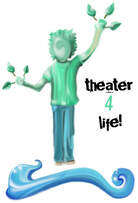 These games are perfect for the lower and middle school class, helping kids to expand their self-confidence and social awareness! 1. The Thumb Grab This is a fun game that teaches self- management and self control. Grades: 3rd+ (although you can try with a younger group) Time: 5-10 minutes How you play:
The fun comes in them not knowing when you’ll say go. To encourage shy or introvert students to practice speaking up, give them a chance to give the countdown. You can give all students a chance give countdowns. Note: The setup may take some time as students tend to get confused about lefts and rights when standing in a circle. 2. Pass the Face This game is all about self expression and social connection. Grades: K+ Time: 5-10 minutes How you play:
3. Energy Circle This is a great game energizes your group and works on body dynamics. With younger groups, you can weave in SEL components exploring emotions, indoor/outdoor voices, etc. The sky's the limit! Grades: 3rd+ (although you can try with a younger group) Time: 5-10 minutes How to Play:
4. Emotional Soundtrack Grades: K+ How to Play:
Note: This is a great game that allows students to explore their emotional states. Even in being silly, there can be conversations around awareness of the body in certain emotional states, and the role that breath plays within those states. 5. I am a Tree! Grades: 2+ Time: 10-25 minutes How to Play:
Bonus: The Never Ending Rock Paper Scissors Game... well, almost This game introduces the concept of Win-Win Situations.
Note: You can change the levels to reflect something your students’ personalities. What’s important is that students know it’s okay to lose, because they will, and will have to go back to the first level. It’s a great lesson in teaching disappointment and self-management and social awareness. Happy Playing!
1 Comment
 In starting Theater4Life!, it’s dawning on me that not everyone is familiar with social emotional learning (SEL), how it works, or why it’s important. So, let’s take a couple of minutes looking at it; and because I’m a theater person, let’s start with a simple imagination exercise: Imagine your typical morning. Maybe it starts with a hectic rush to get out of the home, chaotic whines of misplaced keys and homework, late lunch making, and bad hair days. Or perhaps it’s the total opposite, a comforting cup of coffee in the car while you jam to your favorite tunes. Now imagine how this innocuous beginning affects the rest of your morning and afternoon. Does your “bad” morning turn into an annoying and moody afternoon? Does your “good” morning leave you feeling on top of the world? However your day starts, your morning emotional state can pave the way for the rest of your day affecting your work productivity, your interactions with your coworkers, your family, and can ultimately leave you feeling empowered or completely dejected. Fun fact: Humans are emotional beings! I know that’s a big "duh!", but I find that often we underestimate the role our emotions play in our lives. Indeed, the everyday choices we take for granted are constantly guided by our emotional states. The way we choose to drive, the clothes we buy, the foods we eat, the topics we focus on, and ultimately the way we manage our relationships are all related to whatever emotional state we’re experiencing and the identity we’ve developed in tandem with those states. It’s therefore important that we develop an awareness of our emotions, learning the ways that they drive us, and ultimately understanding ways we create relationships and how we can manage and navigate our feelings. Social Emotional Learning is the curricular focus of establishing positive practices that help students of all ages develop their emotional intelligence and relationship awareness, allowing for empowered approaches to developing life skills. In the 21st century, schools have started to take on the responsibility of teaching social emotional learning for a multitude of reasons, mostly due to the recognition that an emotionally engaged student translates to a student with a positive relationship to their work, their classmates, and their environment. Schools with active and successful SEL programs find significant positive effects on their student populations with students showing better academic performance, improved attitudes and behaviors, and reduced emotional stress. With SEL, lessons and curriculum are crafted around helping students understand five basic aspects: Self Management, Self Awareness, Responsible Decision Making, Relationship Skills, and Social Awareness. Developing these five skill sets becomes essential in helping us confidently establish meaningful goals for ourselves and in developing resiliency when faced with difficulties. With an ever changing and more technologically connected world, these skills will become even more important as new complexities will present new challenges. All of which will need positive collaboration and problem solving abilities. Great! So how do the theater arts relate to any of this? Glad you asked! Whenever I tell people I teach theater, usually I get an encouraging remark related to the importance of public speaking skills. But there is so much more to theater than that! At its essence, theater is about a community coming together and musing on the human experience. Identities and accompanying emotions are examined by characters who reflect on their environment and their relationships. When students learn to embody characters, they go through a process of examining the hows and whys of many emotional experiences. They practice empathy, learning to piece together the experiences of a character, often times finding parallels into their own lives. Furthermore and perhaps more importantly, the very process of creating theater fosters the practice and development of social emotional learning. Theater is never made alone. It is a collaborative effort that requires the physical labor and creativity of many people. Both playful and challenging, theater fosters the practice of those five important skill sets, allowing for transfer of those skills to other areas of life. Relationship skills, social and self-awareness, self-management and responsible decision making all play a huge role during the collaboration, coordination performance, and technical processes of theater making.  So there you have it, a very brief introduction to Social Emotional Learning and the great help that theater provides in developing those important interpersonal skills. Personally, I think that we are experiencing a really exciting shift in education. Can you imagine how different your own life would be, if you were taught how to manage your emotions and conflict as explicitly as you were taught how to read or the sciences? Speaking for myself, I would have greatly appreciated these lessons. It will be interesting to see how teaching these five elements to students will affect human communication and development for the future. For more information regarding Social Emotional Learning, check out the following websites: CASEL (The main leaders in social emotional learning materials) Teaching Tolerance Center for Spiritual and Ethical Education |
SEL TheaterCheck in for SEL activities, games, and articles. ArchivesCategories |


 RSS Feed
RSS Feed
